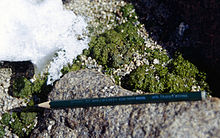Prasiola crispa
| Prasiola crispa | |
|---|---|

| |
| Prasiola crispa found in central Queen Maud Land, Antarctica | |
| Scientific classification | |
| (unranked): | Viridiplantae |
| Division: | Chlorophyta |
| Class: | Trebouxiophyceae |
| Order: | Prasiolales |
| Family: | Prasiolaceae |
| Genus: | Prasiola |
| Species: | P. crispa
|
| Binomial name | |
| Prasiola crispa (Lightfoot) Kützing 1843
| |
| Synonyms[1] | |
|
List
| |
Prasiola crispa is a small terrestrial green alga. It has been recorded world-wide mostly from cold-temperate to polar regions.
Taxonomy
The species, first described as Ulva crispa Lightfoot, is the type of the genus Prasiola.[1] A lectotype was nominated for the species, the type location of which was provided in accompanying notation as walls that faced north and were favoured as urinals.[1]
The specific epithet is said to translate as "crisped", a reference to the irregular convolutions of the species.[1]
Description
This is a small green alga growing to about 6 cm long. The frond is round in shape, flattened. Generally one cell thick, the cells are arranged in rows or in groups of four.[2][3]
It seems to be an important food source for Antarctic collembolans.[4]: 272
The species has been used a model for the study of the effects of high intensities of UV radiation on photosynthesis.[4]: 181
Reproduction
Reproduction is by akinetes and aplanospores.[2]
Distribution
Recorded world-wide mostly from cold-temperate to polar regions,[1] e.g. from Iceland,[5] the British Isles including the Isle of Man, New Zealand, Japan and the Pacific shores of North America.[1][2] In Antarctica, the species lives near penguin colonies.[4]: 593
Conservation status
In Iceland, it is red listed as a vulnerable species (VU).[5]
References
- ^ a b c d e f "Prasiola crispa (Lightfoot) Kützing :: Algaebase". www.algaebase.org. Retrieved 24 May 2019.
- ^ a b c Burrows. E.M.1991. Seaweeds of the British Isles Volume 2 Chlorophyta. Natural History Museum Publications ISBN 0-565-00981-8
- ^ Bunker, F.StP.D., Brodie, J.A., Maggs, C.A. and Bunker, A.R.2017. Seaweeds of Britain and Ireland. Second Edition. Wild Nature Press, Plymouth, UK.ISBN 978-0-9955673-3-7
- ^ a b c Seckbach, Joseph (2007-09-18). Algae and Cyanobacteria in Extreme Environments. Springer Science & Business Media. ISBN 978-1-4020-6112-7.
- ^ a b Náttúrufræðistofnun Íslands [Icelandic Institute of Natural History] (1996). Válisti 1: Plöntur. (in Icelandic) Reykjavík: Náttúrufræðistofnun Íslands.